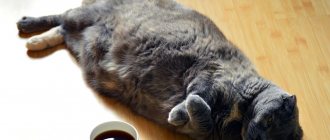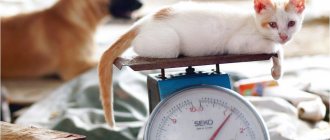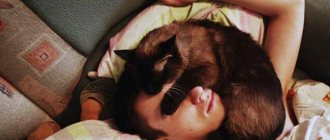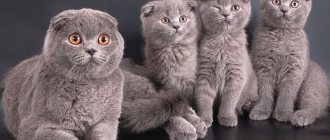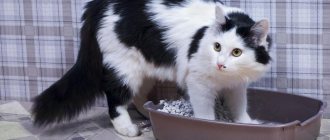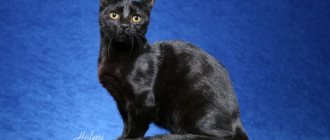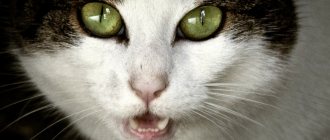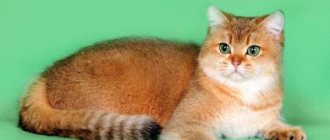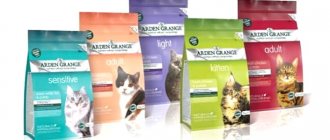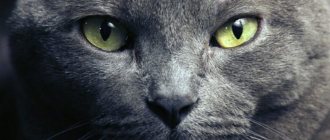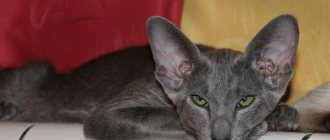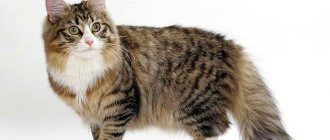Scottish cats (Scottish Fold, Scottish Straight, Highland Fold and Highland Straight) are medium-sized cats, but not small or thin. They are much smaller than the champion Maine Coon, but quite large compared to, say, the Siamese. Compared to the British, Scottish cats are slimmer, their bones are lighter and more graceful. But still, like the British, they are prone to overeating and, as a result, to obesity. Therefore, the owner must monitor their weight.
The weight of Scottish cats depends on many factors, including the heaviness of the skeleton.
Article continues after advertisement
If a cat has heavy bones, she will be heavier with the same external build as a light boned cat. That is, the normal weight of a Scottish cat does not have clear boundaries from start to finish: each pet has its own norm.
Origin story
The only significant difference between Scottish Straight cats and Scottish Fold cats is in the ears. They are not curved, but straight - that’s the whole difference. These cats appeared in the 60s of the last century on an ordinary Scottish farm, and initially the cats’ ears were folded. Breeders, having started breeding a new breed, quickly found out: in litters, both kittens with curled ears and normal ones are usually born, and in addition, the gene responsible for the lop-eared gene negatively affects the health of animals.
The cats' bones thickened, early osteochondrodysplasia appeared, and they died early. Through trial and error, it became clear: the best option for crossing is a cat with straight ears and a fold-eared cat.
The Scottish Straight breed was officially registered in 2004 and immediately became extremely popular.
A kitten not for breeding costs about 5,000 rubles (without documents) and 10,000 rubles with documents. Show-class specimens will cost 18-25 thousand rubles.
Standards
The weight of a Scottish Straight individual is 3-3.5 kg, rarely more.
| Standard | Description |
| Head | The shape of the skull is round, with convex cheeks and forehead. The cheekbones are clearly defined (more so in cats than in cats), the chin is strong. The whisker pads are oval and plump. The nose is short, with a wide bridge and no noticeable stop. |
| Eyes | Large, widely spaced. The iris can be any color. |
| Ears | Large, wide at the base and with rounded tips. The outside is abundantly pubescent, the inside is less, but lush panicles, hard and long, grow on the skin. |
| Torso | Muscular, long, large, but with soft smooth lines. The neck is muscular and short. |
| Limbs | Long, strong, with oval and elastic legs. |
| Tail | Long, dense, reaching the shoulder blades in length. |
| Wool | The coat is thick, dense, and plush to the touch. It can be either short or medium length. Undercoat is present. |
Serious defects are considered:
- turned out toes;
- cryptorchidism;
- creases on the tail;
- short tail;
- small eyes;
- explicit “stop”;
- flat forehead;
- too wide ears.
Weight table by month
The Scottish Straight weight gain graph is clearly demonstrated in the table by month.
| Age | Female (weight in kilograms) | Male |
| 1 month | 0.3-0.65 g | 0.45-0.75 g |
| 2 | 0.45-0.8 g | 0.8-1.6 |
| 3 | 1.25-1.7 | 1.3-2.4 |
| 4 | 1.7-2.35 | 2.1-3.8 |
| 5 | 2.25-3.1 | 2.45-4.2 |
| 6 | 2.3-3.5 | 3.1-5.5 |
| 8 | 2.9-4.3 | 3.4-6 |
| 10 | 3.1-4.6 | 4.2-7.2 |
| 1 year | 3.2-5.3 | 4.6-7.4 |
| 2 and older | 3.4-5.6 | 5.3-8.2 |
Colors
Basic shades (solid):
- Black (a little white wool is allowed, but brown or red is considered a defect).
- White (with amber or copper eyes, or multi-colored eyes).
- Gray (without other color inclusions or patterns).
- Red (patterns on the paws and forehead are allowed).
- Chocolate (plain).
- Lavender (lilac, with a light brown nose and copper-colored eyes).
- Blue (blue: kittens may have patterns on their fur and copper eyes).
- Cream (possible patterns on tail and paws).
- Cinnamon (paw pads and nose - pale pink).
- Faun (eyes are bright, rich copper or amber, nose and paw pads are beige-pink).
- Bicolor colors - an admixture of white on the limbs, belly, chest or face. These are harlequin, van, ticked, shaded, tabby.
In the photo there are Scottish Straight cats of popular colors: black, white, blue
Rare colors: chinchilla, tabby, smoky, color point, calico, tortoiseshell (classic).
When choosing a pet for home keeping, color is not important, but in exhibition activities it is of no small importance. The CFA, for example, does not recognize chocolate, lilac, point, or all colors with white spots.
Scottish cat size
The answer to the question of what size a Scottish cat or cat depends not only on their weight, but also on their body length. There are miniature cats that do not grow much in length, and therefore their body weight should be less. In general, Scottish cats are medium in size. The normal length of a Scottish cat (excluding the tail) is around 55 cm, give or take.
The height of Scottish cats, that is, the height from the floor to the withers, in a standing position on four legs, is approximately 30 cm. This is important to consider when choosing a carrier, because... The cat should be able to stand up to its full height in it without bending down. The same applies to the house tray.
If your cat competes at shows, then not only its overall size becomes important, but also the length of its tail and limbs. Ideally, the tip of the tail should reach the shoulder blades when laid along the body. The paws should not be too thick and short, like those of the British: let us remind you that the skeleton of the Scots is lighter and more graceful.
The body of the Scottish cat is from medium size to large, rectangular in format - not a square, with rounded lines, proportionate at the level of the shoulders and croup. A body that is too stretched or massive is considered a fault. Wide chest. The head is round like a ball, with pronounced whiskers (mustaches) and chin.
Rate and share!
Character and behavior
Looking at the imposing and massive Scottish Straights, you might think that they are lazy and do not see beyond their food bowl. Not at all! Of course, among cats of this breed (as well as among individuals of other breeds) there are many phlegmatic animals, but not all have such a specific character. Scottish Straights are reasonable and careful, they look closely and think for a long time before taking on any business, but this does not mean at all that they are stupid or slow.
Scottish Straights can run as fast as their feline counterparts and love new toys and running around. They just need a little more rest and quiet. They are not hermits or beeches: Scottish Straights love to be the center of attention, but they also easily tolerate loneliness.
The peak of playfulness occurs in the first couple of years of their life; for the rest of the years, cats prefer a leisurely existence in comfort and coziness, next to their favorite representatives of the human race.
They are careful, restrained in expressing feelings, but affectionate and very patient. These are the same cats that you can have in a family with small children. Scottish will never allow himself to scratch a child or scare him with a loud hiss. If the cat is “pushed”, he will silently run away and hide, but will not take revenge. They are not vindictive or vindictive, and do not suffer from mood swings, but they can be very persistent and even obsessive. If they really want something, they will follow you on your heels and scream until victory.
Name the cat who always wanted to live together
BasilioLeopold
They respond well to learning basic skills - going to their litter box (How to train a kitten to use the litter box?), eating at certain hours, not stealing from the table - but training is not for them. They get along well with other cats and even dogs, but they do not like small animals.
A change of environment is difficult for them, as is moving. They are afraid of heights, loud sounds and do not like water.
How to weigh
Determining the weight of a kitten at first glance seems somewhat complicated. However, everything is quite simple.
Methods:
- The first method is the most common, weighing on an electronic kitchen scale. Such scales show the result quite accurately, making weighing kittens from 0 months old very easy and simple.
- The second method also has the right to life. Here it is suggested to use commercial hand scales with a hook. To measure mass this way, you will need a bag or some other container to place the cat in. The container is pre-weighed separately. This method of measurement is far from the most accurate.
- The third method is more likely for adult animals whose weight is from 1 kg. You need floor scales on which you weigh yourself and then weigh yourself with your pet. The difference between the first and second weighing will be equal to the weight of the cat.
- The surest, but not the most convenient way, is to weigh the kitten in a veterinary clinic on special scales.
Care instructions
Scottish straights are extremely clean. They carefully monitor the appearance of their coat and the length of their claws, so these points require minimal attention from you.
If the animal is very dirty, it should be bathed using cat shampoo, and during shedding, it should be combed not once a week, as usual, but 2-3 times. Buy a stable scratching post and place it in a visible place - the cat will quickly adapt to it.
But cats in captivity do not know how to clean their ears and teeth. So this is your task. The ears are wiped weekly with a cotton swab dipped in boiled water or chlorhexidine, and the teeth are brushed every 10-14 days using a special paste and a small toothbrush with soft bristles.
Expert opinion
Dusheba Vera Ivanovna
In 2010, she graduated from the Moscow State Academy of Veterinary Medicine named after K.I. Scriabin with honors, specializing in veterinary medicine. I regularly attend veterinary conferences, congresses, and webinars.
You cannot use human cosmetics and hygiene products, even children’s! The components included in your shower gel or children's toothpaste can cause disturbances in the gastrointestinal tract and even poisoning.
How to weigh a kitten correctly
If the kitten is very small, then in order to weigh it, you can use a regular kitchen scale and a small box. To prevent the kitten from turning weighing into a game, the best time for the process is immediately after sleep. If the baby starts spinning and jumping, the indicators will be inaccurate. Trying to hold a playful baby with your hand can also get a distorted result.
To get the most accurate figure for the baby’s weight, you can follow two methods:
- First, weigh the box, then put the kitten in it and record the result again. Subtract the difference.
- Place the box on the scales, and only then turn them on.
They will show zeros. After this, we put the baby in a box and get the figure for his body weight. It is more convenient to weigh mobile kittens in small containers or boxes to get a more accurate result.
This way the owner will receive an exact figure in grams, which can be entered into the animal’s weight diary.
Catering
The issue of feeding should be approached with all seriousness: you cannot feed a living creature with just anything.
Food that is fatty, over-salted, with artificial preservatives and dyes in its composition will not bring any benefit to your pet, but it can “add” the stomach, liver, and other organs literally once or twice. And not all food from your table is suitable for an animal, even if it is good for you.
Natural products
Digestion is significantly different between humans and cats. The first thing a cat needs is calcium, phosphorus and taurine.
- And these substances can only be obtained from raw meat, lean and fresh: beef, chicken, rabbit, turkey, veal, lamb. During heat treatment, calcium transforms into a form that is practically not absorbed by the body, and taurine completely disintegrates. Meat components (muscle meat, offal, meat bones) should make up 90% of the daily diet.
- 5-10% are vegetables. Pumpkin, carrots, asparagus, zucchini, green beans, cauliflower, broccoli, greens (parsley, dill): vegetables are boiled or stewed and mixed with cereals. Cats rarely eat raw food.
- Rice, millet, oatmeal, buckwheat, semolina and pearl barley porridge are allowed. You can feed your cat with them every other day. Porridge is cooked in plain water without adding sugar, salt or seasonings.
- Chicken and quail eggs can be given no more than 2 times a week. Quails are boiled and fed whole; chicken ones are given only the yolk.
- Fish - flounder, hake, trout, salmon, tuna, navaga, saury, mackerel, ivashi, burbot, tench, chum salmon, carp - contains easily digestible protein, omega-3 and omega-6, and vitamins. But there is practically no calcium there, which causes problems with the musculoskeletal system in Scottish Straight cats. Therefore, fish can be given in small pieces along with meat and no more than once a week. Lack of fish will not negatively affect your cat's health if you add fish oil to the food.
- Low-fat fermented milk products - sour cream, yogurt, fermented baked milk, cream, cottage cheese, unsalted hard cheese - can be given every day, preferably in the afternoon.
- Vitamin-mineral complex, dry yeast in tablets, spirulina, kelp, sprouted alfalfa are very useful and should also be included in the diet.
Potatoes, legumes, cocoa-containing products, juices, alcohol, citrus fruits, bones, flour products and baked goods are prohibited!
Clean water at a comfortable temperature should always be available! You cannot give your animal water directly from the tap: tap water contains bleach and other components hazardous to the cat’s health.
Recommended food
From industrial feeds, choose only super-premium and holistic feeds. Go Natural, Savarra, Wellness CORE - these foods are recommended by both breeders and veterinarians.
Below are recommended super-premium foods. Links with the names of the food are clickable, on them you can, within our website, get acquainted with the descriptions of the food and read reviews from owners of cats of the Scottish Straight breed.
| Holistic | Super premium | Super premium |
| Wildcat | Golosi | Karmy |
To what age do cats grow – Pet-Mir.ru
Looking at a small pet, many owners wonder: to what age do cats grow when their tiny lump turns into a big handsome one. The growth of a cat directly depends on many factors:
- from the breed of the animal;
- on the size of the pet’s parents (heredity);
- from feeding;
- from past diseases.
Important! On average, cats grow up to 14-15 months, but in some animals growth ends a little earlier.
Growth and development of kittens
Kittens of different breeds are born with different weights - from 60 g to 200. This also depends on how many kittens were in the litter: the fewer, the larger the babies will be.
Felinologists distinguish several stages of development and growth of kittens:
- neonatal (1-4 days after birth);
- suckling (1 month);
- transitional (from 1 month to 2);
- post-suction (from 2 months to six months).
At each stage, the baby’s nutrition is decisive. It is up to six months that the formation of the skeleton and the main development of the kitten occurs, so make sure that the diet is balanced and varied. Be sure to give your baby vitamins.
Important! The nutrition of a kitten for up to six months lays the foundation for its development and growth, so be sure to take into account the advice of experts: it is dangerous to both underfeed and overfeed kittens.
Past illnesses will also have a negative impact on the baby’s growth. Therefore, regularly show the kitten to the veterinarian.
Dependence of cat growth on breed
The size of the animal, and accordingly how long it will grow, depends on the breed. Breed characteristics usually indicate how long cats grow. Ordinary (yard) ones, as a rule, are formed by the year.
If the seals are miniature breeds (for example, Munchkin, Singaporean), they reach their maximum size slightly earlier, at approximately 9 months - one year. These animals, by their nature, cannot be large in size, so they can reach their maximum size quite quickly.
Important! According to breed standards, among miniature cats, those individuals that are the smallest in size are especially valued.
Medium-sized animals (British, Scottish) have approximately the same growth rates. Thus, felinologists, explaining to what age British cats grow, indicate that by 10 months to a year these pets reach maturity, while their physical development can last up to two years. It is at this age that animals become especially beautiful. But to what age Scottish Straight cats grow is determined by the characteristics of their breed. They usually reach their maximum size by 2 - 2.5 years. Cats of this breed grow a little faster, by 1.5-2 years, despite the fact that they become sexually mature earlier. These criteria determine the age at which Scottish Fold cats grow.
But representatives of large breeds can sometimes increase in size up to three years. May-Coon, Chausie, and Bengal kittens are born quite large. Up to a year, these animals are at the stage of active growth, after which they gain muscle mass and grow, but not at such a fast pace.
How does feeding affect the growth of cats?
Inadequate nutrition, as well as excess, can affect the growth and development of a pet, so caring owners must take into account feeding recommendations:
- It is better to eat food in the morning and evening, dividing the daily intake equally (or making the morning intake larger);
- do not allow the cat to finish eating after other pets;
- do not feed the animal from your table: your food does not always suit them;
- If your pet eats natural food that you prepare yourself, keep in mind that not all foods are healthy for cats.
- Periodically add vitamins to your pet's food.
Important! If you see deviations from the average norms of development and growth of your cat, be sure to consult a specialist who, if there are no other reasons, will help adjust the diet.
Reasons that inhibit the growth of cats
Animals of the same breed and even those produced by the same parents are not always the same size. There are several reasons that affect growth:
- diet: the foods or feeds you give your pet can stimulate growth or slow it down; abnormal nutrition will certainly affect the size of the animal;
- the presence of parasites in a cat’s body: sometimes it can be difficult to determine, but it is all kinds of worms inside your pet that take away the vitamins and microelements necessary for growth and development;
Important! Veterinarians recommend giving cats anthelmintic drugs twice a year, even if there is no obvious presence of parasites.
- hormonal imbalances: pets, like people, are susceptible to hormonal imbalances; If you observe a sharp jump in growth or, conversely, a slowdown, contact a veterinarian and undergo the necessary examination with the animal.
Important! Sterilizing an animal can affect its growth, so doctors do not recommend this procedure for adult animals: they can suddenly gain excess weight, which will affect their well-being.
Record-breaking animals
The largest cat whose result is recorded in the Guinness Book of Records is the Maine Coon Sweetie from the USA. At 5 years old, he had a length of 123 cm and a tail of 41.5 cm (by the way, Sweetie is also the owner of the longest tail among the representatives of his breed). The cat’s owners said that they didn’t feed their pet anything special, and his growth happened on its own.
Fiz Gel from the USA (Munchkin breed) is recognized as the smallest cat. Her height is only 15 cm. Despite her modest size, she is very mobile: she can easily jump on even the tallest objects.
The Persian Tinker Toy is considered the smallest cat. Its height is only 7 cm and its length is 19 cm. This growth of an adult animal is explained by genetic mutations. But this did not stop the animal from taking its place among the record holders in the book of records.
pet-mir.ru
Diseases
The most common problems are:
- Discharge from the eyes. This is not necessarily a sign of an illness: it is often due to the specific structure of the skull and narrow tear ducts. If the discharge is clear or brown and odorless, there is nothing to worry about. But an admixture of yellow or red pus is a signal of a problem.
- Otitis, ear mites, fungus. If your pet constantly shakes its head and seems to be trying to get something out of its ear, take it to the vet. Maybe something got inside, maybe you scratched the delicate skin while cleaning, or maybe it’s due to the onset of a disease.
- Joint problems (eg osteochondrodysplasia). Over time, the bones become deformed, which is why the animal begins to experience difficulties when walking: it cannot fully straighten its paws, and it is difficult for it to jump.
- Urolithiasis disease. Castrated males are more likely to suffer from this disease. There may be several reasons: lack of vitamins, hormonal imbalance, severe cold, infection, poor diet. The animal begins to run around frequently, stops eating, becomes lethargic, licks itself frequently, and blood is visible in the urine.
- Excess body weight. Scottish Straight cats are prone to obesity, so their diet should be monitored especially carefully.
Expert opinion
Dusheba Vera Ivanovna
In 2010, she graduated from the Moscow State Academy of Veterinary Medicine named after K.I. Scriabin with honors, specializing in veterinary medicine. I regularly attend veterinary conferences, congresses, and webinars.
Whether or not to vaccinate your pet is up to each owner to decide for himself. But remember: you can bring pathogens into the house on your hands, clothes, and shoes. In this case, even thorough washing and disinfection of the premises may not save the animal from infection. Distemper, panleukopenia, calcivirosis, rabies are mortally dangerous and without vaccinations your beloved creature will face a painful death. In addition, without vaccinations you will not be able to take your cat abroad.
Chart of animal weight gain from birth to 2 years
The period of puberty is important. At this time, growth slows down. If cats come into heat 1-2 times a month, then growth may stop altogether
If you have sterilized a cat, then at first its body weight will increase slowly, but later there is a threat of obesity due to the fact that its immunity increases.
A kitten's weight is a very important aspect of its development. The baby's weight needs to be monitored for several reasons. For example, by the age of one month, a kitten can weigh up to 500 grams. If his weight differs from this indicator in the direction of decrease, this may be caused by the following reasons:
- diseases, congenital or acquired;
- numerous litters;
- the mother’s lack of a complete diet that can provide nutrition for both the cat herself and her babies.
An underweight kitten may indicate that the baby is malnourished. He becomes lethargic, sleeps a lot, and apart from the general mass of kittens. In this case, you need to increase the amount of food for the nursing cat and monitor how long the weak baby stays at her breast.
Sometimes he still managed to get comfortable, but he quickly got tired and soon fell asleep without having eaten enough. Since I closely followed the adaptation of foundlings, I immediately noticed this (literally within 24 hours). The baby had to be fed separately. I gave him a special mixture, but also tried to get him to latch on to the cat’s breast more often (the more lively brothers had to be pushed aside for a while). As a result, this baby still lagged behind the others in weight, but caught up with them in height by about a year.
If a kitten is diagnosed with any disease, then to correctly calculate the medicinal suspension you will also need to know the exact weight of the animal. Therefore, a conscientious owner always monitors this indicator.
Every caring owner should keep a kitten's weight diary. This must be done regardless of whether the kitten grows up alone or with its mother cat and brothers. It is necessary to record all weight indicators in the diary, which can later help track whether the baby is developing normally.
The weight diary can be kept in any form, as convenient for the owner. This is an ordinary notebook for me. In it I write down the date of birth of the kittens, the names I gave them, as well as everything related to caring for them. This is not only their weight, but also the dates of treatment for fleas and worms, as well as the dosage of drugs (which, by the way, depends on weight).
There are several internal and external factors influencing the growth processes of a Scottish Fold cat kitten. Internal factors are presented:
- characteristics of the breed;
- gender;
- genotype of parents;
- individual genetic characteristics;
- hormonal characteristics.
External factors affecting the growth of an animal include keeping kittens during the neonatal and suckling periods, as well as the number of individuals in the litter, quality of sleep and dietary features of a nursing cat. Animals must be provided with a completely calm, stress-free environment, good and nutritious food, as well as high-quality hygienic care.
You can feed your Scottish Fold cat both natural products and ready-made dry or wet food. The second option, according to many breeders and veterinarians, is more preferable for normal growth and development, therefore it is recommended to purchase the following ready-made diets for feeding your pet:
- AATU;
- Asana;
- Applaws;
- Canagan;
- Сarnilove;
- Farmina N{amp}amp;D;
- Gather;
- Gina Elite;
- Go Natural;
- Grandorf;
- Nature;
- Now Fresh;
- Nutram;
- Orijen;
- Pronature Nolistis;
- Savara;
- Wellness CORE.
